
Photo sobory.ru
The covered porch gallery of the Church is entirely painted with frescoes.
The Frescoes in the Church of the Beheading of John the Baptist
in Yaroslavl - Tolchkovo
1700

Photo
sobory.ru
The
covered porch gallery of the Church is entirely painted with
frescoes.
In 1977 the Tolkhovo church was boarded up and no begging by my friend Genya would unlock the door. So I was delighted to find this collection of reproductions of its freescoes in the Russian internet. Because of the number of images I prepared this separate webfile.

Portal of the Church.
Several
Yaroslavl artists worked in the church: Dmitry Grigoriev Plekhanov,
who worked in Moscow, Rostov, the Trinity-Sergius Lavra, and Vologda
was the master craftsman. His assistant was Fyodor Ignatiev, a
talented and experienced fresco painter in his own right.
Photo
artclassic.edu.ru
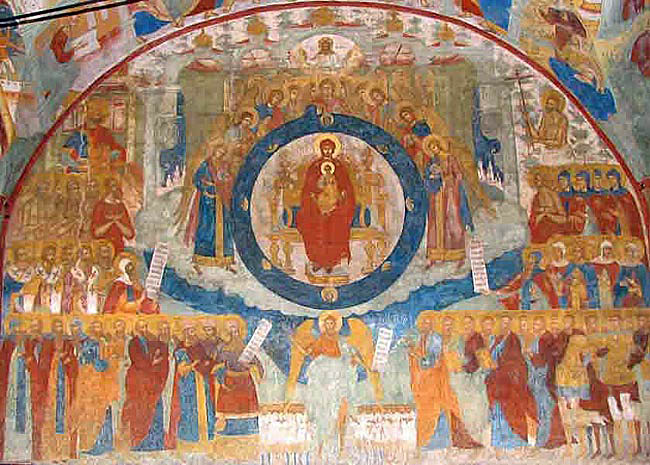
Multi-figure
composition of "O, you happy ..." with expanded
iconographic story - one of the best frescoes in the cycle of the
church
Photo artclassic.edu.ru
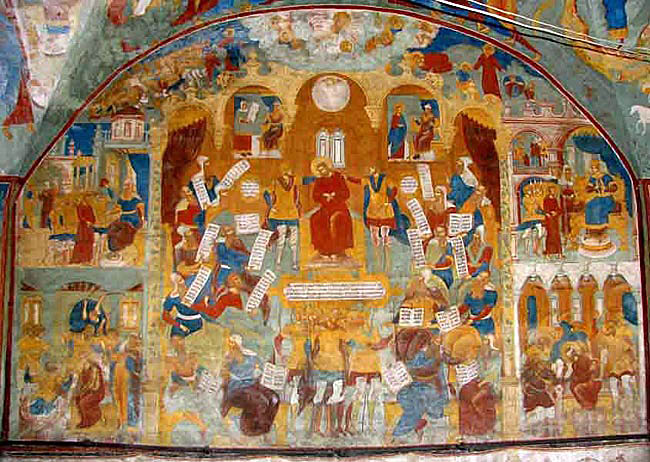
The
Passion of Christ
In the center of the huge mural depicting an apocryphal Jewish Sanhedrin court, sits Jesus being sentenced to death. The scene is loaded with details. Supreme Jewish judges hold the scrolls with the indictment.
The top right of the Savior shows his disciples asleep in Gethsemane, the garden at the foot of the Mount of Olives. Here, they spent most of the night, Christ - in prayer over the chalice. Above left Christ is taken into custody: Judas Iscariot arrives followed by armed men, the chief priests, and the elders of Israel.
Then
the story unfolds on the description of the accused Son of Man in
front of the Roman and Jewish authorities: Christ before Anna, Christ
before Caiaphas, Christ before Pilate, who sent him to the Tetrarch
Herod Antipas, who held the power in Galilee. He is mocked and
ridiculed by Herod and flogged.
Photo artclassic.edu.ru
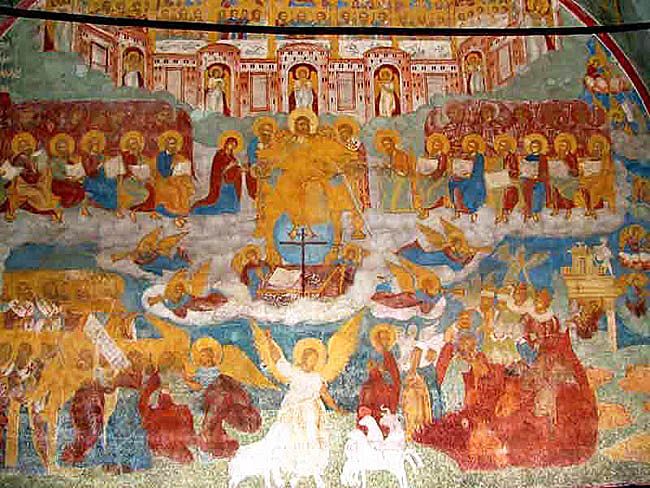
The
Last Judgment
In
this fresco a shortened version of the text is presented. Attention
is drawn to a scene of "The Separation of sheep from the goats",
an allegory for the righteous and the sinners. Characteristic is that
the sinners in hell are in Western clothes: to the medieval Orthodox
notions, all non-Orthodox should burn in the fire. At the top is a
paradise in the form of a fortified city guarded by angels. Inside
there are many mansions built for different grades of holiness.
Photo artclassic.edu.ru
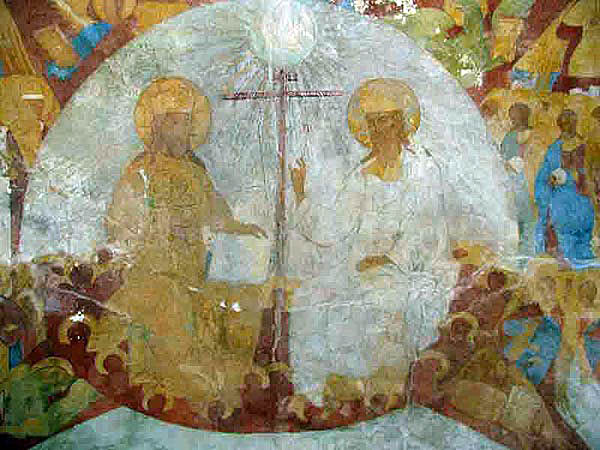
Rare
non-canonical versions of the New Testament Trinity
God Father is placed on the right side of the frescoes in the form of an old man in a white tunic. His right hand blesses Christ. At the top the Holy Spirit is represented by the symbolic image of a dove.
This rare version of the "Trinity" known in Russian as "the Father's Land", was apparently motivated by a desire to make simple folk see the fate of Jesus Christ after his crucifixion and ascension into the kingdom of God, where he should sit on a celestial throne at the right hand of his Father.
By
the edict of the Great Moscow Council of 1666-1667 images of God
Father were forbidden, as well as the Holy Spirit as a dove, with the
exception of the iconography of the "Epiphany" (
"Epiphany"). However, "The New Testament Trinity"
enjoyed wide popularity. It appeared not only on the walls of
churches, but on their iconostases as well. Parish priests often
refered to such images carefully and critically. However, this did
not prevent the spread of the "New Testament Trinity" in
the XVII century and later, and nowadays it is found everywhere,
especially in new churches.
Photo
artclassic.edu.ru

“The
Land of the Father”, another non-canonical
version of the New Testament Trinity
God
the Father, instead of the Mother of God as in previous centuries,
sits with Christ Emmanuel in his lap as infant.
Photo
artclassic.edu.ru

The
Jerusalem Virgins before the Shulamith
Tradition ascribes the text to the "Song of Songs" of King Solomon. It is a part of the "Old Testament". In the Orthodox interpretation of the "Song of Songs" predicts the love of Christ for his bride, the Church.
In the mural, as in the ancient hymn, praising Shulamith is expressed with grandeur and solemnity. The festively dressed maidens of Jerusalem admire ger beauty. In the clouds, Jesus Christ points at the text, and the Holy Spirit descends on Shulamith as a dove.
The
Tolkovo frescoes were based on Biblical illustration by Piscator.
However, the Yaroslavl masters moved further, volumetrically and in
spatial composition. All murals appear united in a common rhythm.
They feel like poetic fairy-tales, the lyricism of Russian
folklore.
Photo artclassic.edu.ru
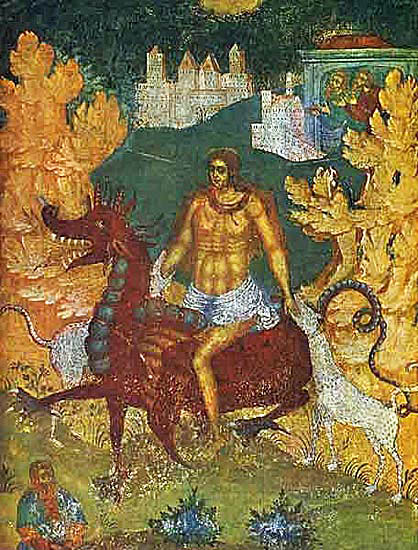
“The
Condemnation of the woman who did not confess her sins”
Yaroslavl fresco painters, intelligent artistc observers of contemporay urban life and love, painted not only sacred, but with great freedom scenes of their time. The painters were not afraid of images of the naked female body. In prescribing the story of David and Bathsheba, naked harlots and sinners appear riding on snakes or in a chariot. These colorful, narrative and entertaining images woven into everyday motives and details are sometimes not without satirical allusions.
A
number of such stories in the Tolkhovo Church were borrowed from
Western literature. Thus, for example, "The condemnation of the
woman who did not confess her sins" appears to have been taken
from a Catholic anthology of legends "Star Radiant." In the
second half of XVII century this book was translated into Russian and
enjoyed wide popularity. At the end of the century "Star
Radiant" even went to press, but the book was published, one
might think, because it clearly expressed the nature of Catholic
beliefs, i.e. , of deplorable Western, non-Orthodox themes.
Photo
artclassic.edu.ru